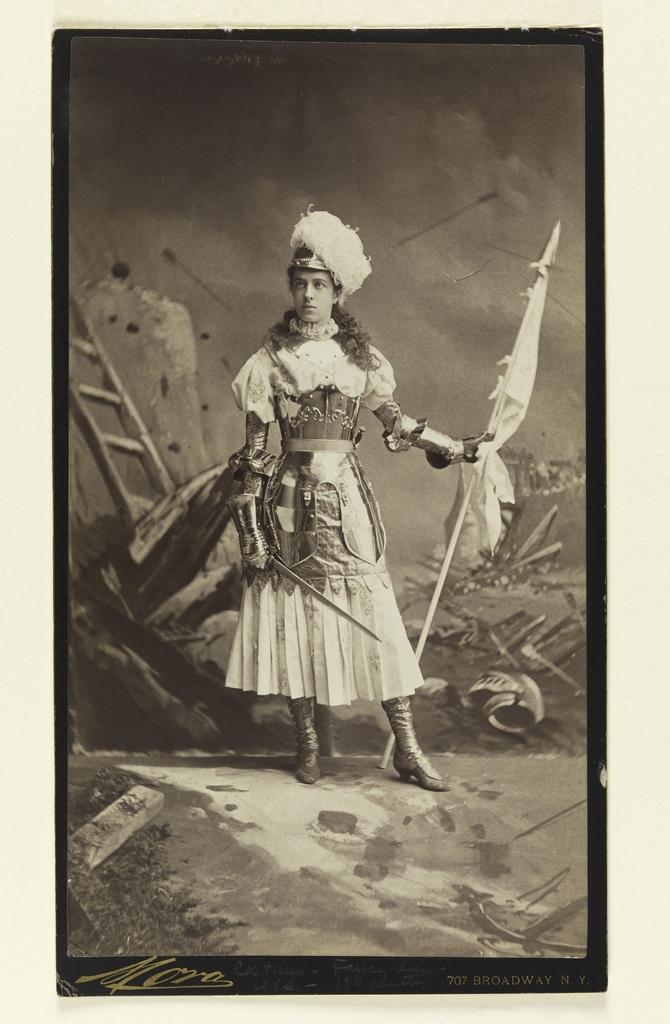There is one other image of this object. This image is in the public domain (free of copyright restrictions), and as such we offer a high-resolution image of it. See our image rights statement.
See more objects with the color lightgrey darkolivegreen grey dimgrey darkslategrey or see all the colors for this object.
Object Timeline
|
1960 |
|
|
2013 |
|
|
2014 |
|
|
2016 |
|
|
2025 |
|
Photograph, Mrs. Peter Cooper Hewitt in Masqurade Costume
This is a Photograph. It was photographed by Jose Maria Mora. It is dated ca. 1885 and we acquired it in 1960. Its medium is photograph on sensitized paper. It is a part of the Drawings, Prints, and Graphic Design department.
She Wore Spurs of Steel
It’s hard to say which looks more lethal, her sword or her high-heeled shoes? Miss Lucy Work (1861-1934), the soon to be Mrs. Peter Cooper Hewitt, is seen here as Joan of Arc. The elaborate costume was said to have cost $1,500. During the Gilded Age, women frequently wore costumes for fancy dress balls and private theatricals. Work wore this outfit on March 26, 1883 to Mrs. William K. Vanderbilt’s infamous costume ball. José Maria Mora, the famous society photographer, commemorated Work as the Maid of Orléans two years later in a tableau.
Lucy Work was considered “the famous star of private theatricals” in New York City. The creation of tableaux vivant (French for living pictures) was a popular theater game from the mid-nineteenth to the early twentieth century. During a tableau vivant, scenes from literature, art, or the everyday were performed on a stage by models where they would hold their silent poses for roughly thirty seconds. Upper class women were especially involved in the genre because it was a tool for showing off their social stature. As well, the performance provided them with an opportunity to try on a new identity, especially one that might not have been socially acceptable. A tableau allowed women to merge their private and public image, to discover and reveal something new about who they were.
Work’s choice of wearing Joan of Arc’s costume reveals something about her personality, and it was an especially interesting choice for a woman to make in 1883. Joan of Arc was a controversial figure because she traded in her domestic role for a traditionally male role as a soldier. Her behavior was often overlooked because she was answering to a higher calling; three saints had appeared to her in a vision and told her to fight for the King of France. Her religious devotion eventually overshadowed her gendered rebellion. Work’s facial expression and body language suggest that she felt connected to Joan’s vision and determination. Dressed in armor, what could Lucy Work want to fight for? As a member of high society, Work could leverage her privilege to wear the costume of a radical woman.
Politically, the image of Joan of Arc was frequently used during the Suffrage campaign. Joan was a revolutionary and fiercely loyal to her country. This was just the sort of image the suffragists needed. In 1913, the Suffragette newspaper, published by the Women’s Social and Political Union, described Joan of Arc as “not only the perfect patriot but the perfect woman.” She could be both radical and womanly, a paradox for the Modern Woman. Political or not, Lucy Work embodied this conflict with courage and grace.
This object was featured in our Object of the Week series in a post titled She Wore Spurs of Steel.
- Mural, Dutch Clouds
- digital print on cellulose, latex, nylon substrate.
- Gift of Maharam.
- 2012-11-2-1/5
- Drawing, View of a Masquerade Ball
- pen and black ink, brush and gray wash, watercolor on laid paper.
- Purchased for the Museum by the Advisory Council.
- 1911-28-39
- Dress, from Fall / Winter 2013 collection
- crocheted organic cotton.
- Courtesy of Sandra Backlund.
- 12.2015.1
Its dimensions are
32.5 x 18.5 cm (12 13/16 x 7 5/16 in.)
It is inscribed
On mount, printed: Mora...707 Broadway N.Y.
Cite this object as
Photograph, Mrs. Peter Cooper Hewitt in Masqurade Costume; Photographed by Jose Maria Mora (Cuban-American, 1850 - 1926); USA; photograph on sensitized paper; 32.5 x 18.5 cm (12 13/16 x 7 5/16 in.); 1960-60-1



